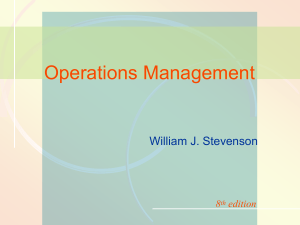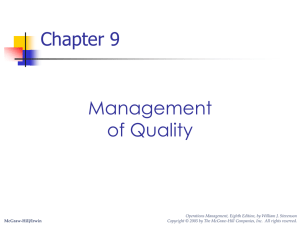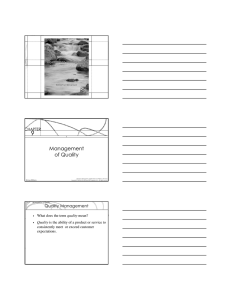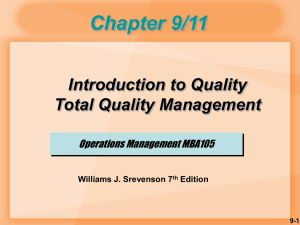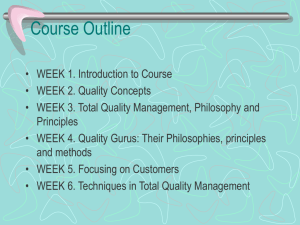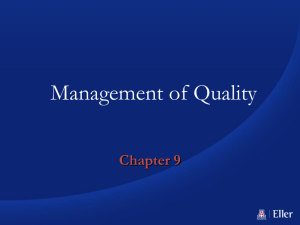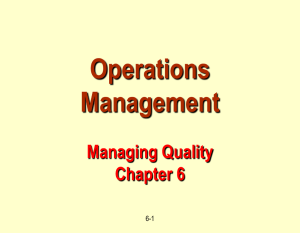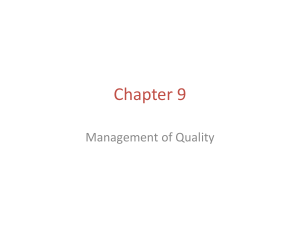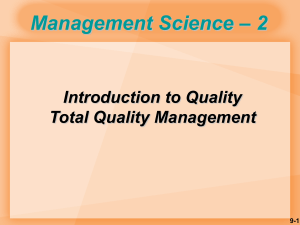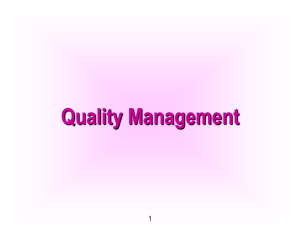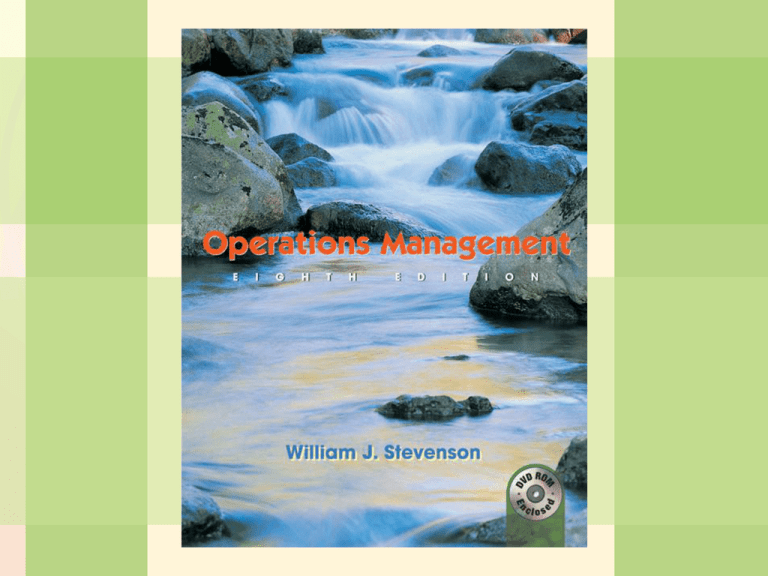
9-1
Management of Quality
Operations Management
William J. Stevenson
8th edition
9-2
Management of Quality
CHAPTER
9
Management
of Quality
McGraw-Hill/Irwin
Operations Management, Eighth Edition, by William J. Stevenson
Copyright © 2005 by The McGraw-Hill Companies, Inc. All rights reserved.
9-3
Management of Quality
Quality Management
What does the term quality mean?
Quality is the ability of a product or service to
consistently meet or exceed customer
expectations.
9-4
Management of Quality
Evolution of Quality Management
1924 - Statistical process control charts
1930 - Tables for acceptance sampling
1940’s - Statistical sampling techniques
1950’s - Quality assurance/TQC
1960’s - Zero defects
1970’s - Quality assurance in services
9-5
Management of Quality
Quality Assurance vs. Strategic Approach
Quality Assurance
Emphasis on finding and correcting defects
before reaching market
Strategic Approach
Proactive, focusing on preventing mistakes
from occurring
Greater emphasis on customer satisfaction
9-6
Management of Quality
The Quality Gurus
Walter Shewhart
“Father of statistical quality control”
W. Edwards Deming
Joseph M. Juran
Armand Feignbaum
Philip B. Crosby
Kaoru Ishikawa
Genichi Taguchi
9-7
Management of Quality
Key Contributors to Quality Management
Table 9.2
Contributor Known for
Quality
Deming
14 points; special & common causes of
variation
Juran
Quality is fitness for use; quality trilogy
Feignbaum
Quality is a total field
Crosby
Quality is free; zero defects
Ishikawa
Cause-and effect diagrams; quality
circles
Taguchi
Taguchi loss function
9-8
Management of Quality
Dimensions of Quality
Performance - main characteristics of the
product/service
Aesthetics - appearance, feel, smell, taste
Special Features - extra characteristics
Conformance - how well product/service
conforms to customer’s expectations
Reliability - consistency of performance
9-9
Management of Quality
Dimensions of Quality (Cont’d)
Durability - useful life of the product/service
Perceived Quality - indirect evaluation of
quality (e.g. reputation)
Serviceability - service after sale
9-10
Management of Quality
Examples of Quality Dimensions
Dimension
(Product)
Automobile
(Service)
Auto Repair
1. Performance
Everything works, fit &
finish
Ride, handling, grade of
materials used
Interior design, soft touch
All work done, at agreed
price
Friendliness, courtesy,
Competency, quickness
Clean work/waiting area
2. Aesthetics
3. Special features Gauge/control placement Location, call when ready
Cellular phone, CD
Computer diagnostics
player
9-11
Management of Quality
Examples of Quality Dimensions (Cont’d)
Dimension (Product)
Automobile
(Service)
Auto Repair
5. Reliability
Infrequency of breakdowns
Work done correctly,
ready when promised
6. Durability
Useful life in miles, resistance
to rust & corrosion
Work holds up over
time
7. Perceived
quality
Top-rated car
Award-winning service
department
8. Serviceability Handling of complaints and/or Handling of complaints
requests for information
9-12
Management of Quality
Service Quality
Tangibles
Convenience
Reliability
Responsiveness
Time
Assurance
Courtesy
9-13
Management of Quality
Examples of Service Quality
Table 9.4
Dimension
Examples
1. Tangibles
Were the facilities clean, personnel neat?
2. Convenience
Was the service center conveniently located?
3. Reliability
Was the problem fixed?
4. Responsiveness
Were customer service personnel willing and able
to answer questions?
5. Time
How long did the customer wait?
6. Assurance
Did the customer service personnel seem
knowledgeable about the repair?
7. Courtesy
Were customer service personnel and the
cashierfriendly and courteous?
9-14
Management of Quality
Determinants of Quality
Design
Ease of
use
Conforms
to design
Service
9-15
Management of Quality
Determinants of Quality (cont’d)
Quality of design
Intension of designers to include or exclude
features in a product or service
Quality of conformance
The degree to which goods or services
conform to the intent of the designers
9-16
Management of Quality
The Consequences of Poor Quality
Loss of business
Liability
Productivity
Costs
9-17
Management of Quality
Responsibility for Quality
Top management
Design
Procurement
Production/operations
Quality assurance
Packaging and shipping
Marketing and sales
Customer service
9-18
Management of Quality
Costs of Quality
Failure Costs - costs incurred by defective
parts/products or faulty services.
Internal Failure Costs
Costs incurred to fix problems that are detected
before the product/service is delivered to the
customer.
External Failure Costs
All costs incurred to fix problems that are detected
after the product/service is delivered to the
customer.
9-19
Management of Quality
Costs of Quality (continued)
Appraisal Costs
Costs of activities designed to ensure quality
or uncover defects
Prevention Costs
All TQ training, TQ planning, customer
assessment, process control, and quality
improvement costs to prevent defects from
occurring
9-20
Management of Quality
Ethics and Quality
Substandard work
Defective products
Substandard service
Poor designs
Shoddy workmanship
Substandard parts and materials
Having knowledge of this and failing to correct
and report it in a timely manner is unethical.
9-21
Management of Quality
Quality Awards
Baldrige Award
Deming Prize
9-22
Management of Quality
Malcolm Baldrige National Quality Award
1.0 Leadership (125 points)
2.0 Strategic Planning (85 points)
3.0 Customer and Market Focus (85 points)
4.0 Information and Analysis (85 points)
5.0 Human Resource Focus (85 points)
6.0 Process Management (85 points)
7.0 Business Results (450 points)
9-23
Management of Quality
Benefits of Baldrige Competition
Financial success
Winners share their knowledge
The process motivates employees
The process provides a well-designed quality
system
The process requires obtaining data
The process provides feedback
9-24
Management of Quality
The Deming Prize
Honoring W. Edwards Deming
Japan’s highly coveted award
Main focus on statistical quality
control
9-25
Management of Quality
Quality Certification
ISO 9000
Set of international standards on quality
management and quality assurance, critical to
international business
ISO 14000
A set of international standards for assessing
a company’s environmental performance
9-26
Management of Quality
ISO 14000
ISO 14000 - A set of international standards
for assessing a company’s environmental
performance
Standards in three major areas
Management systems
Operations
Environmental systems
9-27
Management of Quality
Total Quality Management
A philosophy that involves everyone in an
organization in a continual effort to improve
quality and achieve customer satisfaction.
T
Q
M
9-28
Management of Quality
The TQM Approach
1.
2.
3.
4.
5.
Find out what the customer wants
Design a product or service that meets or
exceeds customer wants
Design processes that facilitates doing the
job right the first time
Keep track of results
Extend these concepts to suppliers
9-29
Management of Quality
Elements of TQM
Continual improvement
Competitive benchmarking
Employee empowerment
Team approach
Decisions based on facts
Knowledge of tools
Supplier quality
Champion
Quality at the source
Suppliers
9-30
Management of Quality
Continuous Improvement
Philosophy that seeks to make never-ending
improvements to the process of converting
inputs into outputs.
Kaizen: Japanese
word for continuous
improvement.
9-31
Management of Quality
Quality at the Source
The philosophy of making each
worker responsible for the
quality of his or her work.
9-32
Management of Quality
Statistically
Six Sigma
Having no more than 3.4 defects per million
Conceptually
Program designed to reduce defects
Requires the use of certain tools and
techniques
9-33
Management of Quality
Six Sigma Programs
Six Sigma programs
Improve quality
Save time
Cut costs
Employed in
Design
Production
Service
Inventory management
Delivery
9-34
Management of Quality
Six Sigma Management
Providing strong leadership
Defining performance merits
Selecting projects likely to succeed
Selecting and training appropriate people
9-35
Management of Quality
Six Sigma Technical
Improving process performance
Reducing variation
Utilizing statistical models
Designing a structured improvement strategy
9-36
Management of Quality
Six Sigma Team
Top management
Program champions
Master “black belts”
“Black belts”
“Green belts”
9-37
Management of Quality
Six Sigma Process
Define
Measure
Analyze
Improve
Control
DMAIC
9-38
Management of Quality
Obstacles to Implementing TQM
Lack of:
Company-wide definition of quality
Strategic plan for change
Customer focus
Real employee empowerment
Strong strong motivation
Time to devote to quality initiatives
Leadership
9-39
Management of Quality
Obstacles to Implementing TQM
Poor inter-organizational communication
View of quality as a “quick fix”
Emphasis on short-term financial results
Internal political and “turf” wars
9-40
Management of Quality
Criticisms of TQM
Blind pursuit of TQM programs
Programs may not be linked to strategies
Quality-related decisions may not be tied to
market performance
Failure to carefully plan a program
9-41
Management of Quality
Basic Steps in Problem Solving
1.
2.
3.
4.
5.
6.
7.
Define the problem and establish an
improvement goal
Collect data
Analyze the problem
Generate potential solutions
Choose a solution
Implement the solution
Monitor the solution to see if it accomplishes
the goal
9-42
Management of Quality
The PDSA Cycle
Plan
Act
Do
Study
9-43
Management of Quality
Process Improvement
Process Improvement: A systematic
approach to improving a process
Process mapping
Analyze the process
Redesign the process
9-44
Management of Quality
The Process Improvement Cycle
Select a
process
Document
Study/document
Evaluate
Seek ways to
Improve it
Implement the
Improved process
Design an
Improved process
9-45
Management of Quality
Process Improvement and Tools
Process improvement - a systematic
approach to improving a process
Process mapping
Analyze the process
Redesign the process
Tools
There are a number of tools that can be used
for problem solving and process improvement
Tools aid in data collection and interpretation,
and provide the basis for decision making
9-46
Management of Quality
Basic Quality Tools
Flowcharts
Check sheets
Histograms
Pareto Charts
Scatter diagrams
Control charts
Cause-and-effect diagrams
Run charts
9-47
Management of Quality
Check Sheet
Billing Errors
Wrong Account
Wrong Amount
A/R Errors
Wrong Account
Wrong Amount
Monday
Management of Quality
80% of the
problems
may be
attributed to
20% of the
causes.
Pareto Analysis
Number of defects
9-48
Off
Smeared Missing Loose Other
center print
label
9-49
Management of Quality
Control Chart
Figure 9.11
1020
UCL
1010
1000
990
LCL
980
970
0
1
2
3
4
5
6
7
8
9 10 11 12 13 14 15
9-50
Management of Quality
Cause-and-Effect Diagram
Figure 9.12
Methods
Materials
Cause
Cause
Cause
Cause
Cause
Cause
Environment
Effect
Cause
Cause
Cause
People
Cause
Cause
Cause
Equipment
Management of Quality
Run Chart
Diameter
9-51
Time (Hours)
9-52
Management of Quality
Tracking Improvements
Figure 9-17
UCL
UCL
UCL
LCL
LCL
LCL
Process centered
Process not centered and stable
and not stable
Additional improvements
made to the process
9-53
Management of Quality
Methods for Generating Ideas
Brainstorming
Quality circles
Interviewing
Benchmarking
5W2H
9-54
Management of Quality
Benchmarking Process
Identify a critical process that needs
improving
Identify an organization that excels in this
process
Contact that organization
Analyze the data
Improve the critical process
9-55
Management of Quality
CHAPTER
9
Additional PowerPoint slides
contributed by
Geoff Willis,
University of Central Oklahoma.
9-56
Management of Quality
GURUS
DEMING
JURAN
CROSBY
ISHIKAWA
9-57
Management of Quality
7 Basic Tools
Flow Chart
Check Sheet
Histogram
Pareto Chart
Scatter Diagram
Cause & Effect Diagram
Statistical Process Control
9-58
Management of Quality
Flow Chart Example:
Self-Serve Gas Before Improvement
Drive in
shut off
engine
check price self serve? to pump
walk to pay
station
yes
no
check card transmit
approved?
turn on
pump
back
to car
pump
gas
walk to
booth
wait
yes
no
copy to
file
employee
totals
charges
check
accuracy
prepare
receipt
sign
copy
copy to
wallet
return to car
on the road
again
9-59
Management of Quality
Drive in
Flow Chart Example:
Self-Serve Gas After Improvement
check
price
shut off
engine
go to
pump
self-serve?
yes
insert
card
in pump
no
approved?
yes
check
credit card
wait
wait for
receipt
store in system
on the road
again
pump gas
no
copy to
wallet
Management of Quality
Example
Exam Score
9-60
Homework Problems
9-61
Management of Quality
Quality/Safety
STA09
Pixux systems
9-62
Management of Quality
Service, Personnel
SDHM5
Training, guestware support

